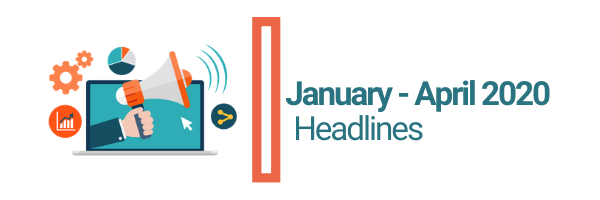
We talk through the biggest digital marketing updates from January to April 2020.
The start of 2020 has been a rollercoaster ride. Domestic politics and Brexit squashed consumer confidence at the start of the year. Fast-forward two months and a worldwide pandemic catapulted retailers and consumers into even more uncertainty.
The team at Green Ginger Digital have taken time to reflect on the first quarter of 2020 and have rounded up the retail and digital highlights for you.
Covid-19 severely impacts UK retailers
It wouldn’t be a review of the last 4 months if we didn’t mention Covid-19. With many countries still in lockdown, it will remain a talking point for many months to come.
Covid-19 has been a story of 2 halves for retailers. Categories such as home and garden, electricals and even beauty saw huge uplifts in demand in the first weeks of April, according to the latest figures by IMRG. On the flip side, we saw clothing retailers struggle, particularly in holiday related categories. Analysis from GlobalData published at the end of March declared UK retail could lose £12.6bn this year.
Announcements of immediate closures came from Warehouse, Next and Quiz. As well as administration for Debenhams and Cath Kidston. Covid-19 has been the final nail in the retail coffin for those who were teetering on the brink.
For some retailers, it has forced diversification. Local restaurants and takeaways have changed strategies to ensure they continue to make money. Large corporations and supermarkets such as Aldi have also been forced to do the same. Aldi announced they would now sell groceries online for the first time. Ensuring those who are vulnerable and self-isolating, can have a box of essential goods delivered to their doors.
We’re sure retailers and marketeers alike are keeping a watchful eye on Primark. The fast-fashion giant has gone from generating £650m, to nothing overnight because of their lack of online presence. Only time will tell whether they will bow down to pressure and start trading online, or stick to being a store-only experience.
Large shifts in digital consumer behaviour have occurred
Of course, large shifts in customer behaviour have been observed over the last couple of months due to the pandemic. Sales plummeted at the end of March when retailers closed stores to protect employees and customers. eCommerce was reported to have gained its largest-ever share of retail spending, at 22.3% of total sales. Essential purchases were front of mind for customers. Online food sales grew by almost 20% in March, yet online clothing sales were down by 4.4% vs. the previous year, according to a report by InternetRetailing.
A study by Ecommerce agency Melody suggests that the changing behaviour consumers are displaying may continue into the future. 12% of surveyed customers said they are likely to continue buying items online that they previously bought on the high street. The role of Amazon has become ever more prominent, with 19% of consumers turning to the online giant to fulfil their purchases. The breadth of product offering combined with quick and easy delivery, will this further grow Amazon’s share of the market?
Both streaming services (the likes of Disney+ and Netflix) and social media have benefitted from the lockdown. There has been a 25% increase in engagement on key platforms such as Instagram and TikTok. This has, of course, led to brands increasing their investment through Paid Social, with a 72% increase on #ad content by influencers.
Google receives pressure to reduce any new algorithm updates
Almost 60% of the SEO community in a recent poll think Google should pause changes to Google SERPs, including algorithm updates during the pandemic. Of course, at the start of the year who could have predicted the situation, we would be in today? The first core update of the year was on January 13th, following strong peak 2019 trading. A broad core algorithm update of this type is one which impacts many factors, with its primary focus being to better match user queries to search engine results.
According to Moz, the categories hit most by the algorithm update were ‘health, family and community’ and ‘beauty and personal care’. With sites such as www.verywellhealth.com, finace.yahoo.com and www.dictionary.com fairing pretty well from the update.
As this was a core update impacting all algorithm factors, if you were harmed in January there is nothing specific to ‘fix’. You can read our beginners guide to SEO to understand more about the ranking factors that influence your performance, plus the actions you can take to address any ranking fluctuations.
Google delays changes to agency partner accreditation criteria
Within the paid space we have also seen updates, with Google announcing it would be changing how it gives agencies its ‘partner’ accreditation. These changes definitely received mixed emotions when they were announced in February 2020. Many agencies feel that this is another attempt by Google to force compliance and the use of Google’s own technology.
The key changes Google announced are:
- Google Ads accounts must maintain a quality score of 70% or higher. This will be impacted by the amount of machine learning recommendations an account adopts from the Google interface
- Google Ads accounts must maintain a spend of at least $20,000 over a 90 day period (twice the current criteria amount)
- At least 50% of the users with access to Google Ad accounts must have passed Google Ads examinations (vs. the current rule of just one user)
Thankfully it was announced on 8th April 2020 that Google is delaying the review process of its partner’s badge programme. Agencies across the country breathed a collective sigh of relief as they now have until 2021 to hit Google’s criteria.
Free Google Shopping listings announced
Way back in 2002 shopping on Google was known as Froogle. A platform for advertisers to list their products for free. Fast forward a few years to 2012 and Google Shopping was launched. Charging an auction-based CPC for listing individual products.
Google announced at the end of April 2020 that they would be rolling out free Google Shopping listings in the US. With a global launch to follow shortly after – read our thoughts on the announcement here.
The free listings will be shown within the organic section of the SERPs as we’re used to seeing today. With auction-based paid for ads occupying the top spots in the search engine results pages. The results? More choice for customers and increased competition for advertisers. As businesses who didn’t play in this space before due to budget reasons, add their product feeds to the auction.
Google is further cementing this announcement with a partnership with Paypal. Focusing on keeping users within the search engine results pages rather than off to websites to make their purchases. This is an interesting move from Google. Particularly when you consider the fine they received in 2017 from the EU, for monopolising the search results pages.
So, all in all, an interesting start to the year. Nobody could have guessed the impact Covid-19 would have on digital and retailers alike, and we’re sure the fall out will be seen for years to come.
Sign up to our newsletter to make sure you don’t miss our next round-up at the end of August!














